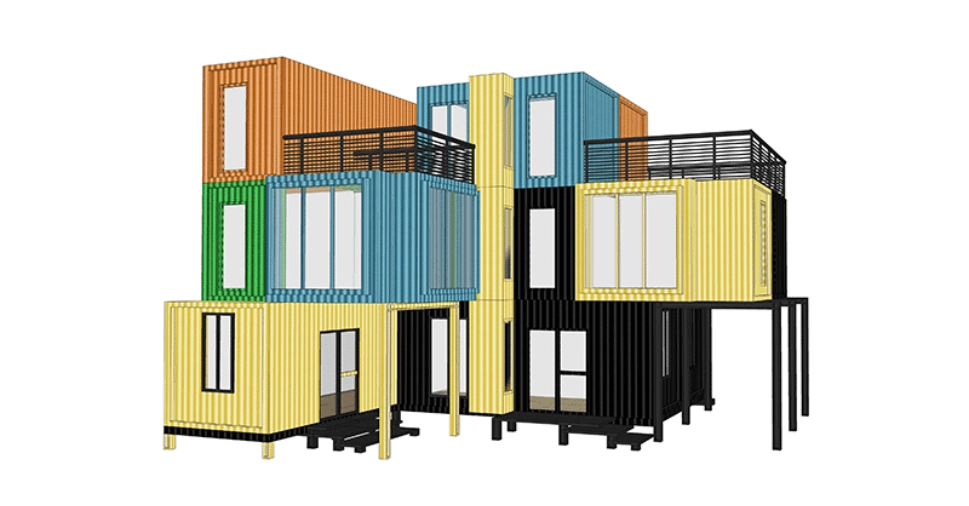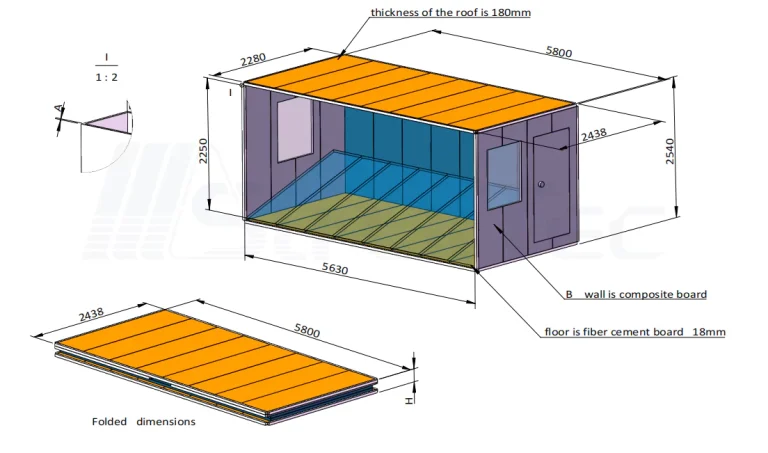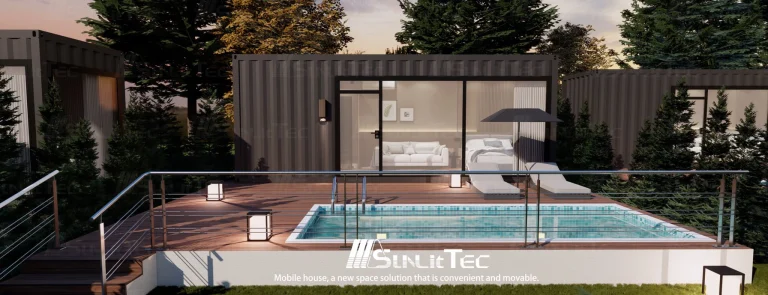
As the global housing industry moves toward sustainable and cost-effective construction methods, modular homes have become a popular solution. Container homes are a prime example. For both developers and individuals, these homes provide quick deployment, modern designs, and a smaller environmental footprint. However, a complex network of logistical challenges exists behind the appeal, which manufacturers must handle to guarantee smooth delivery and installation. From sourcing steel containers to final on-site utility hookups, every phase requires careful coordination. This article looks into these global logistics problems and explores how companies like Sunlit Tec are creating new ways to solve them.
Global Supply Chain Complexities in Container Home Manufacturing
The creation of container homes is greatly affected by global supply chain dynamics. In fact, this process requires precise coordination across continents and industries.
Key Components in the Container Home Supply Chain
First of all, the process involves finding core materials like steel containers and structural reinforcements, which are frequently bought from different international markets based on cost, availability, and trade rules. Most mobile homes are built with a modular design, where each part acts like a separate “building block.” This allows parts to be prefabricated in a factory. Then, they are moved to the site for fast assembly. What’s more, this method supports both whole-unit shipping and modular breakdown to fit logistical requirements.
Besides raw materials, the supply chain must also sync the work of design teams, fabrication plants, and customization workshops. These units might be in different countries. Thus, they require constant supervision and uniform procedures. Quality control at every step is absolutely vital to uphold structural integrity, safety, and visual appeal.
International Shipping and Transportation Hurdles
Manufacturers often run into big shipping delays. These come from congested ports, customs holdups, or a lack of cargo containers. While being able to export in a containerized form helps lower shipping expenses, this benefit can be lost due to transit interruptions from geopolitical issues or natural disasters.
Packaging methods play a big part here. The modular design makes moving and setting up more convenient, allowing for simple disassembly and combination as needed. Plus, shipping modules in a flat-pack style helps reduce damage during transit while also permitting flexible loading arrangements.
Supplier Coordination Across Borders
Manufacturers must manage various lead times from component suppliers and synchronize deliveries with production schedules. It’s a big job. Language barriers, time zone differences, and spotty communications often make working with foreign vendors more difficult.
The solution to this again is standardized paperwork, such as comprehensive installation guides and customs forms. Container homes can be exported in large quantities and then divided by module, a process that makes transport more flexible. However, without consistent documentation and project tracking systems, delays can ripple through the entire supply chain.
On-Site Deployment Challenges for Modular Container Homes
While global logistics set the stage, the success of a modular home installation depends on overcoming site-specific problems. A lot can go wrong.
Site Preparation Requirements
Before any modules show up, the foundation must satisfy structural safety rules. Gravel foundations are forbidden because of erosion risks. Instead, you need hardened surfaces like concrete pads or cement bases with bolts set in them. On sloped or uneven ground, the installation of concrete pillars ensures placement that is level and prevents settling of the structure over a period of time. To this end, Sunlit Tec assists customers in determining the most appropriate base type for the land they are on, further improving safety and increasing ease of installation.
Transporting and Positioning Modules on Site
Logistical issues don’t stop after delivery. Moving oversized container units through tight roads or faraway areas often needs special vehicles and careful route planning. After that, cranes or forklifts have to lift and place each module precisely. This is a task made harder by weather like strong winds or rain. The modular design of models such as the منزل الحاويات C2 allows them to be taken apart and put together as required, which helps simplify on-site stacking and alignment in different space-limited situations.

Utility Integration and Local Compliance
Once the structure has been assembled, the next step involves the connection of local utilities: plumbing, electrical systems, HVAC. In the process, everything must be done in accordance with the local building codes and zoning regulations. Since each area has its particular rules and specifications, this automatically means that a modular design needs to be adapted for the locality. To complement this, Sunlit Tec also provides models suitable for off-grid solutions, such as solar power systems or mobile trailer setups where permanent foundations are not possible.
Strategies to Optimize the Container Home Supply Chain
To make operations smoother from the factory to the final assembly, manufacturers should use proactive plans that cut down on delays and improve coordination.
Streamlining Logistics Through Pre-planned Coordination
One great technique is matching production schedules with international shipping timetables early in the planning process. This reduces warehouse storage times. It also avoids the problems of port congestion. Furthermore, using digital supply chain tools provides real-time tracking of shipments, inventory, and vendor activities, which allows for quick fixes when problems come up.
Localizing Assembly When Possible
Setting up regional hubs for the final steps of assembly can greatly lessen the burden of long-distance transport. These hubs are useful. They can also act as support centers where local contractors finish final installations or utility connections more effectively, leading to faster response times.
Improving Communication Between Stakeholders
Companies should, therefore, adopt centralized project management platforms to avoid miscommunication. The tools provide a single location for blueprint sharing, timelines, compliance papers, and change orders. Meetings at regular intervals from clients, suppliers, logistics firms, and local authorities also ensure that everyone is on the same page.
Highlighting Sunlit Tec as a Trusted Container House Supplier
Among the many global container home manufacturers, صنلايت تيك stands out because of its product variety, quality commitment, and site-specific customization. They are a great choice.
Overview of Sunlit Tec’s Capabilities and Product Range
Sunlit Tec has a broad selection of modular units. This includes models with balconies, small mobile homes called “space capsules,” and two-story structures that mix space efficiency with attractive design. Their main focus is on easy assembly, design flexibility, and lasting durability in many different environments.
Commitment to Quality Assurance and Customer Support
All their structures are designed to meet international safety standards. If a part fails during the warranty period, the company will ship a replacement component. It is important to note, however, that it does not offer on-site repair services. This promise ensures dependability without saddling users with surprise maintenance duties.
Customization Options Based on Site Conditions
Sunlit Tec knows that every site is different. Therefore, they provide customized solutions like bolt-fixed concrete bases for stability on sloped ground or trailer-mounted designs for mobile uses. Their team helps customers through the whole foundation selection process based on unique terrain features, guaranteeing structural integrity from the very beginning.

Final Thoughts on Overcoming Deployment Barriers
The path from factory creation to a livable modular home requires synchronized planning across continents and fields of expertise. It is a long journey. Success demands early-stage coordination between design teams, suppliers, shipping companies, and local contractors. So, manufacturers must find a balance between global sourcing efficiency and local deployment readiness by using technology and forming regional partnerships. Choosing a skilled supplier like Sunlit Tec greatly lowers risks, making them a reliable partner for modern housing needs.
الأسئلة الشائعة:
Q1: Can a container house be placed directly on gravel?
A: No. Gravel foundations are not advised due to possible erosion. A hardened, level surface like a concrete base is necessary to ensure safety and stability.
Q2: Is a monitoring or alarm system included with Sunlit Tec container homes?
A: No. Sunlit Tec does not install monitoring or alarm systems in its modular homes as a standard feature. Customers can add such systems on their own.
Q3: What happens if a part is damaged during the warranty period?
A: If a part gets damaged within the warranty period, Sunlit Tec will send a replacement component. However, the company does not provide repair services.



